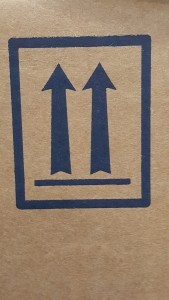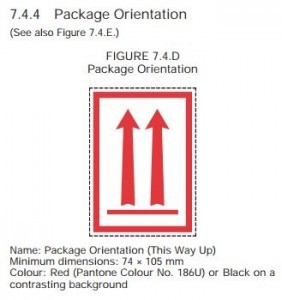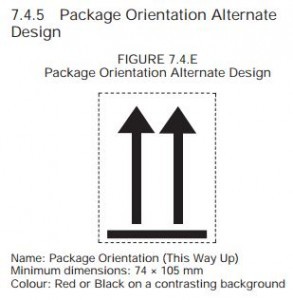A question during the summer of 2018 (07.24.18):
Daniel,
I am emailing you in reference to your article from 2015 on Package Orientation Arrows on HazMat Packaging: https://danielstraining.com/package-orientation-arrows-on-hazmat-packaging/
Is there any instructions on the requirements for these arrows/labels? Meaning does this have to be a certain size, color, multiple colors, etc…
I ship my product in a vented, 20 L container which is blow molded. I would like to incorporate the arrows in the mold itself so that I do not have to slap on one of these stickers every time. Please advise. Thanks!
Like this article? Subscribe to my Monthly Newsletter No marketing emails! |
My reply that same day:
Thank you for contacting me. Please see below.
- The specifications for the appearance of the orientation arrows within the domestic regulations of USDOT/PHMSA can be found at 49 CFR 172.312(a)(2). Orientation arrows must be:
- Similar to illustration shown (see below for example).
- Black or red on white or other contrasting background.
- Commensurate with size of package. Exact dimensions are not specified.
- Rectangular border around arrows is optional.
- Specifications for appearance within IATA Dangerous Goods Regulations (transport by air) are at 7.2.4.4.
- Same specifications as shown at 7.4.D or 7.4.E. (see below for images from IATA Dangerous Goods Regulations).
- Also acceptable are pre-printed package orientation labels of the same specifications as Figure 7.4.D or 7.4.E (ISO Standard 780:1997).
- Black or red on white or other contrasting background.
- Minimum dimensions of 74 x 105 mm.
- “THIS END UP” or “THIS SIDE UP” may be displayed on top of package.
- “Dangerous Goods” may be inserted on the label below the line.
- Specifications for appearance within IMO Dangerous Goods Code (transport by vessel) at 5.2.1.7.
- Similar to illustration shown (see below for image from IMO Dangerous Goods Code).
- Also acceptable are package marks meeting the specifications of ISO 780:1997
- Rectangular
- Of a size that is clearly visible commensurate with the size of the package. Exact dimensions are not specified.
- Black or red on white or other contrasting background.
- Rectangular border is optional.
In all cases there must be two arrows and they must be displayed on two opposing sides.
I hope this helps. Please contact me with any other questions.
Daniels Training Services, Inc. 815.821.1550 |
Conclusion:
That seemed to do it. I hope he was able to incorporate the arrows into the blow mold the way he intended. While I enjoy informing people of the regulations, I enjoy it even more when they are able to save money and improve their business because of it.



 The 57th Edition of the Dangerous Goods Regulations (DGR) of the International Air Transport Association (IATA) specifies the requirements for, and exclusions from use of, package orientation arrows on certain packages of dangerous goods when transported by air.
The 57th Edition of the Dangerous Goods Regulations (DGR) of the International Air Transport Association (IATA) specifies the requirements for, and exclusions from use of, package orientation arrows on certain packages of dangerous goods when transported by air.


